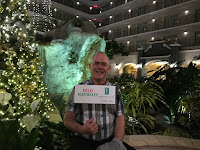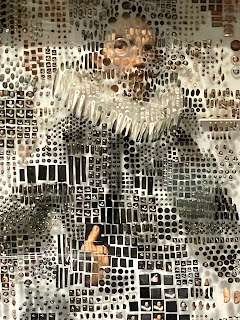Traveling during the holidays sheds a different light on how people celebrate the December holy days and holidays. I have found that many countries, cultures, families, and individuals have similar traditions... but with a personal twist that has been passed down and altered.
Most people recognize the Man-in-Red whether he is called Santa Claus or Father Christmas (English, American), Kris Kringle (American), Père Noël (French: Father Christmas), Papa Noel (Spanish: Father Christmas), Babbo Natale (Italian: Daddy Christmas), Weihnachtsmann (German: Christmas Man), Ded Moroz (Russian: Grandfather Frost), or Święty Mikołaj (Polish: St. Nicholas).
Last year during the pandemic, I came across a San Diego version: Santa Claus on a paddle board!
 |
| How do you experience the holidays? (Photo: Mission Bay, San Diego - 2020) |
We see decorated trees, manger scenes, and lights brightening the darkness. Christmas or holiday music plays nonstop reminding us of religious beliefs and memories of Christmases Past. I have experienced Christmas in the dark winter months (northern hemisphere) and the long, bright evenings of summer months (southern hemisphere).
The spirit of Christmas permeates many of the countries throughout the world.
 |
| What brightens your life? (Photo: Fed Square, Melbourne Australia - 2018) |
Our beliefs and symbols may come in contact and in conflict with others. For instance, I have heard some people reacting strongly when they see the word Xmas -- assuming that X is replacing Christ. "Keep Christ in Christmas" becomes the rallying cry! This is where we might stop, ask questions, and listen to what is in another person's heart and understanding.
In the early days of the Christian church, the letter X (Greek letter for Chi) was used as a secret symbol by Christians. It was the first letter of the Greek word, Christ, and was used to identify believers. Knowing the Greek meaning of X allows us to understand that Xmas and Christmas are synonymous: we are each pointing to the Christ Mass celebrated.
 |
| How do you balance your beliefs and symbols? (Photo: The Malecon, Ensenada - 2017) |
Therefore, knowing the similarities and differences in our beliefs and symbols allows us time to reflect on our cultural or familial celebrations. Replacing judgment with curiosity invites us to see where we feel at home... or where we might be uncomfortable. The important question when we are ill-at-ease: Why?
 |
| Where do you feel at home? (Photo: Church of Our Lady of Guadalupe, Puerto Vallarta - 2019) |
These December holy days and holidays require one thing of us: we are invited to see and celebrate the humanity that is gifted in each person we encounter.
May this holy season bring a Pause into our lives. May we embrace the exhortation: "Peace and Goodwill to All!"
 |
| Larry Gardepie (click on link for website) |









